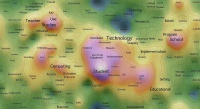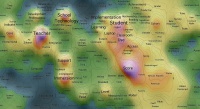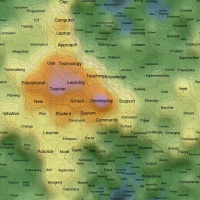OLPC research
This page provides links to research reports related to the OLPC project. See also Experience, Constructionism, Reviews of OLPC, and Class Acts (a FLOSS Manuals community publication) for articles and other anecdotal evidence.
- Overviews/summaries of OLPC distributions to date
- 2007-2010: an Assessment and Overview of international M&E Reports, by the the OLPCF Learning Team.
- 2009-2010: an Evaluations review 2009-2010 building on the above
- As of 2011: New papers and evals are being discussed at OLPC research/papers.
Contents
- 1 Literature Reviews
- 2 OLPC experiences
- 2.1 Research papers and reports
- 2.1.1 CEIBAL Reports
- 2.1.1.1 Official overviews, December 2009
- 2.1.1.2 Work by Hourcade / Flores
- 2.1.1.3 Ceibal Assessment 2010 Summary Document .doc
- 2.1.1.4 Síntesis del informe de monitoreo del estado del parque de XO a abril de 2010.
- 2.1.1.5 Monitoreo y evaluación educativa del Plan Ceibal: Primeros resultados a nivel nacional
- 2.1.2 Recent pilot report
- 2.1.3 OLPC Haiti pre-pilot evaluation report (IDB)
- 2.1.4 One Laptop Per Child Pilot Project [Addendum to Comprehensive Technology Plan]
- 2.1.5 Experimental Assessment of the Program "One Laptop Per Child" in Peru
- 2.1.1 CEIBAL Reports
- 2.2 Eduvision Ethiopia Implementation Report, Sep-Dec 2007
- 2.3 First Experiences with OLPC in European Classrooms
- 2.4 Nepal
- 2.5 US research and reports
- 2.6 Topical studies
- 2.7 Stakeholder and Partner Country presentations
- 2.8 Essays, Reflections, public Debates
- 2.9 Economics
- 2.1 Research papers and reports
- 3 One to One computing, ICT4D, Collaborative learning technology
- 3.1 Promoting the Knowledge Economy in the Arab World
- 3.2 Designing Collaborative Learning Tech for the Developing World (Hoadley, et al.)
- 3.3 Educational Outcomes and Research from 1:1 Computing Settings (Bebell, O'Dwyer. JTLA)
- 3.4 Quantitative Results from the Berkshire Wireless Learning Initiative (Bebell, Kay. JTLA)
- 3.5 After Installation: Ubiquitous Computing and High School Science in 3 Schools (Drayton, et al. JTLA)
- 3.6 Implementation Fidelity of Tech Immersion and Student Achievement (Shapley, et al. JTLA)
- 3.7 Laptops and Fourth Grade Literacy (Suhr, et al. JTLA)
- 3.8 The End of Techno-Critique: The Naked Truth about 1:1 Laptop Initiatives (Weston, Bain. JTLA)
- 3.9 1:1 Technologies/Computing (Ethiopia)
- 3.10 ICT learning study for Chile. PISA Results 2006 (Kluttig, et al.)
- 3.11 Autonomous Learning Skills: Education and Technology for Strengthening Culture (Colombia)
- 3.12 Evaluation In OLPC: What For? What Has Been Done, What Could Be Done?
- 4 Ongoing Research (not yet published)
- 5 Other Resources
Literature Reviews
Assessment of OLPC Evaluations
- OLPC Foundation Learning Team: Assessment and Overview of Existing M&E Reports
Recently published assessment of existing international M&E literature by local and government actors on OLPC distributions.
- Evaluation of OLPC programs globally: a literature review, Version 4, by Dita Nugroho and Michele Lonsdale. Australian Council for Educational Research, August 2010. PDF Country program summaries, with XO deployment data, funding, and reported outcomes and impacts.
The Australian Council for Educational Research conducted its own review several times a year, including summary observation. They provide a good overview of both formal and informal evaluations of OLPC programs in 12 countries. They include timelines, methodologies, and outcomes (or expected outcomes). While their meta-evaluation shows positive global trends in evaluation of OLPC programs, they note that most programs have begun only recently. Different evaluations covered vary in scope, methodology, and stakeholders.
The authors encourage the need to address evaluation in the early stages of program design and planning to build understanding of design, implementation, and results.
- L’évaluation des déploiements OLPC : quelles méthodes ? (PDF), In French, 22 pages, August 26th 2010, by Pierre Varly, consultant, member of OLPC France

- Evaluation in OLPC: What for ? what has been done, what could be done? (PDF), October 22nd 2010, by Pierre Varly, consultant, member of OLPC France
- Evaluations in OLPC, slideshow, October 22nd 2010, by Pierre Varly, consultant, member of OLPC France
One to One Laptop Schools review
http://en.wikibooks.org/wiki/One-to-One_Laptop_Schools
Excerpt: High-level overviews of the major 1:1 projects around the world, including the Magellan project and many OLPC projects. Descriptive more than stats-based; tends to have good coverage of projects up to launch, following published media and interviews, but not beyond. A true wikibook, changing slowly over time.
OLPC experiences
OLPC has helped country leaders plan and commit to national education projects involving 1-to-1 use of laptops in schools since 2006. In January 2005, OLPC announced an intent to design a laptop for children and make learning with child-owned laptops the norm, and by January 2007 the first "XO" laptop trials<ref>For the purposes of this review, distributions and deployments mean schools or larger educational groups in which all children in certain grades and all of their teachers have their own laptop. </ref> were underway with primary school children and teachers, in Brasil, Nigeria, and Peru. As of December 2009, OLPC has shipped 1.2 million XO laptops to 31 countries.
Countries planning large-scale national deployments of XOs for primary schools ("country partners") began making public commitments to olpc in 2007.<ref>Initially Peru, Nigeria, Argentina, Libya, Thailand and Uruguay.</ref> Feedback was gathered about changes to the laptop<ref> Including at a detailed country meeting in 2007</ref>, and the earliest deployments of the mass-production version of XO laptops (XO-1) began in Peru and Uruguay in late 2007.<ref>There were a few significant revisions in the XO-1 design over the following year: strengthening the keyboard membrane to improve its thickness and lifespan, and improving the robustness and responsiveness of the touchpad.</ref>
National plans for project-based learning, adjusted national teaching standards, community and family engagement through XOs, and digital publishing of activities and school materials, have developed furthest in Peru and Uruguay. Both of those countries have steadily expanded their programs in size and scope since 2007.
Research papers and reports
Separate page Academic papers was merged to this one
CEIBAL Reports
Official overviews, December 2009
slightly manicured report for official government consumption, based on many thousand respondents to an opinion and perception survey, apparently no objective or other data sources were used. No "negative" outcomes reported in the conclusions.
El presente resumen de evaluación educativa contiene los primeros datos representativos a nivel nacional producidos en torno al Plan Ceibal.
Monitoreo y evaluación del Plan CEIBAL Poblaciones beneficiarias. Impactos en el acceso Impactos en el uso de computadoras en niños y familias Resultados e impactos desde una perspectiva social Opiniones y valoraciones de la población Síntesis y balance de impactos positivos, alertas y desafíos a futuro
Work by Hourcade / Flores
By Hourcade and Pablo Flores, an Uruguayan national who led some of the volunteer initiatives during the planning year of the CEIBAL project and produced the handbook that went home to the family of every child with an XO.
- One year of experiences with XO laptops in Uruguay
An update on the original "Early OLPC experiences" paper, below.
- Early OLPC experiences in an Uruguayan School (pdf)
This report on the first Uruguayan XO pilot, with 150 students in a rural school, provides a good observational overview of XO activities in the classroom.
Uruguay as a country has now reached saturation of primary schools with XOs, and has a couple of independent long-range assessments underway; this study is an interesting historical footnote to those. Technical problems with beta machines including problems with the XO interface were cited as hindrances to learning and collaboration. The study observed positive impact with students as content creators, growing interest in reading and writing, and growth of reseach via the Web.
- Reflections on a Pilot OLPC Experience in Uruguay (pdf)
- Juan Pablo Hourcade, Daiana Beitler, Fernando Cormenzana, and Pablo Flores, 2007, Uruguay
...A two-page position paper presenting opinions regarding a pilot in Uruguay. From empirical data and observations, a positive impact on the children and their school activities is claimed by this Uruguayan team...
- one of the authors has indicated current challenges are different, see Pablo Flores' May 2009 comment here
Ceibal Assessment 2010 Summary Document .doc
English translation of Evaluación del Plan Ceibal 2010 DOCUMENTO RESUMEN http://www.anep.edu.uy/anepweb/servlet/main004?403
File:Ceibal Assessment 2010 Summary Document .doc
Síntesis del informe de monitoreo del estado del parque de XO a abril de 2010.
Executive Summary of the 2010 OLPC monitoring report (Spanish) (http://www.ceibal.org.uy/docs/Plan_Ceibal____Informe_Estado_XO__Abril_2010.pdf)
Monitoreo y evaluación educativa del Plan Ceibal: Primeros resultados a nivel nacional
Plan Ceibal 2010 Monitoring Report (Spanish) Salamano, I., Pagés, P., Baraibar, A., Ferro, H., Pérez, L., & Pérez, M. (http://www.ceibal.org.uy/docs/evaluacion_educativa_plan_ceibal_resumen.pdf)
Recent pilot report
details to come. formal report by pilot observers
Positive impact seen from a 300-student pilot. Parents, students, teachers and community members see benefits program. Ministry officers see clear potential benefits for schools. Appreciation was repeatedly expressed in interviews with participants. There were some technical difficulties with charging, for instance, but the technology was generally accepted in this rural community. More technical support and training of locals is needed, with ongoing evaluation.
In the first term, students showed pride of ownership, had something to share with their faimliy, showed increased attendance and socializing with other students at school. Parents were able to learn as well, and similarly had a way to help children with their learning.
OLPC Haiti pre-pilot evaluation report (IDB)
Internal assessment report, focused on a small sample.
The Education Division of the Inter-American Development Bank (IDB) conduted an assessment following their partial funding of the current program in Haiti. The report provides an analysis of usage trends and outcomes for grades 1-5 after studying 50 students, assessed by interviews and observations.
Gains were observed particularly in literacy (reading and writing) and student preparedness for the future (research about / envisioning their future work options). Teachers, technical staff, and administrators were also interviewed. Data analysis and interview guides are included in the document.
One Laptop Per Child Pilot Project [Addendum to Comprehensive Technology Plan]
http://www.box.net/shared/k6fsitchrvtquv7jvrut
Produced by the Republic of Marshall Islands Ministry of Education, this document outlines the Project Implementation Plan for the OLPC Pilot in the Marshall Islands. It is an addendum to the MOE Comprehensive Technology Plan.
Experimental Assessment of the Program "One Laptop Per Child" in Peru
(http://idbdocs.iadb.org/wsdocs/getdocument.aspx?docnum=35422036) Inter-American Development Bank July 2010
Even though this program has only recently been implemented, this document presents a few preliminary findings that could be relevant for its future development. On the one hand, we find evidence of better attitudes and expectations among teachers and parents; students that are more critical of school work and of their own performance; and a greater development of technological skills among girls and boys. On the other hand, there seems to be a decrease in the intensity of computer use in the classroom, as time passes and difficulties arise in the implementation of the project. Due to the short interval of time since implementation, no impact was observed in learning. This should be verified in future surveys.
Eduvision Ethiopia Implementation Report, Sep-Dec 2007

Ethiopia Implementation Report, September - December 2007,
- Bjorn Everts, Matthew Herren, David Hollow, Eduvision, February 2008
Somewhat massaged report combining short-term observations with a whitepaper promoting the non-profit's own work and software (used in conjunction with OLPC) with an eye towards their future fundraising. Limited data, casual methodology, some interesting anecdotes; not academic. See the discussion about this document.
Eduvision is a small educational non-profit that has proposed its pedagogical aids as useful classroom options for Ethiopia's deployment. They sponsored this report, which discusses the educational setting and modes of teaching in Ethiopia, presenting them as necessary cultural guidelines for successful adoption. The study recommends Eduvision's methods and tools as an incremental step toward creative thinking and independent inquiry for students in Ethiopia's system.
The study involved 12 teachers trained to teach XO basics to classes of 2d, 7th, and 8th graders. After distribution and use for 2 months, students were given batteries of activity tests, task completion tests, and questionnaires. Structured interviews were then held with students and teachers. Positive changes observed and tracked included
- productive changes in teaching styles (of teachers)
- increased student collaboration and dialogue
- support of eachother's learning process and objectives
Student motivation improved, and introducing gaming was cited as a way to promote attention to the curriculum.
Ghana: The One Laptop per Child Project and Its Applicability to Ghana (BOA)
Buchele & Owusu-Aning (pdf). Designed as an academic overview of work in Ghana so far, providing data and raising questions for anyone considering a national implementation.
This paper presents an assessment of OLPC in Ghana with an equitable approach to criticism. Buchele was in charge of part of teacher training for Ghana's first OLPC efforts. 'Applicability' is explored in terms of human development (particularly literacy), access to education, and specific ICT goals currently set forth by the Ghanaian Education Ministry.
The assessment refers to Ghana as a country most suited for OLPC collaboration. Challenges for implementation and funding, and questions for the government to answer, are discussed.
OLPC regional case studies: Asia, Africa, Europe and Latin America (Hooker)
This is a broad review of four OLPC projects in Ethiopia, Nepal, Ireland and Uruguay, including strategies for implementation and educational context. Some basic analysis and key findings are summarized.
First Experiences with OLPC in European Classrooms
First Experiences with OLPC in European Classrooms describes early programs in Graz, Austria. 10/30/2009
Nepal

Tackling the Problems of Quality and Disparity in Nepal's School - Education: The OLPC Model. File:SDBhatta.pdf.
- Dr. Saurav Dev Bhatta, OLE Nepal, June 2008
The paper argues that utilizing the full potential of the OLPC concept requires simultaneous work in four areas: digital content development, teacher preparation, network and power infrastructure development, and government capacity development. And it also emphasizes the need for a systematic approach to implementation where the implementers start by learning to solve implementation challenges in a test phase...
Formative Evaluation of OLPC Project Nepal: A Summary
http://blog.olenepal.org/index.php/archives/321
- "Rabi Karmacharya, OLE Nepal, June-August 2008
This is a summary of the findings of a formative evaluation carried out by Mr. Uttam Sharma, a doctoral student at at the Department of Applied Economics at the University of Minnesota. The evaluation was carried out for OLE Nepal’s internal purpose. The results are expected to help learn about the shortcomings of the current test phase of the OLPC project so that necessary fine tuning can be done before next year’s larger deployment in more districts.
US research and reports
Using Affordable Technology to Decrease Digital Inequality (Birmingham)
Shelia Cotten, et al published initial survey data from the 2008-2009 school year and its aftermath as part of their series of publications on the OLPC program in Alabama. Published 2011, based on 2009 data. This report focused on positive results for students who chose to take advantage of the program, differences that might account for teacher and student interest in taking advantage of it, and the value of bridging the digitial divide.
Evaluation of the Teaching Matters OLPC Pilot at Kappa IV (New York)

- Evaluation of the Teaching Matters One Laptop Per Child (XO) Pilot at Kappa IV.
- Dr. Susan Lowes, Director, Research and Evaluation; and Cyrus Luhr, Research Assistant. Institute for Learning Technologies, Teachers College/Columbia University, June 2008.
"Although the students saw the advantages of the XO in terms of its various specific functions or pieces of software, one theme that ties all these reported activities together is the several ways that the XOs allowed students to share: whether they were using the XOs for writing, taking photos, making videos, chatting, or whether they were rotating their screens or using the software to share them virtually, they were in every case sharing their thoughts or sharing their work.
"When asked if there were existing functions that they would like to use more frequently, [the students] listed the creative software (Etoys, TurtleArt, and TamTamEdit) that could have educational uses but are not currently integrated into the Teaching Matters curriculum."
Topical studies
Using OLPC technology as a Computer: Computer Science Case Study (Buchele)
This paper gives a technial overview of the XO as a computer that can be used as a learning catalyst in computer science classes. Well suited to help students understand topics from design of computer architectures to communication networks, to the development of educational software. Points to use by community beyond the primary school education system.
OLPC for Health Clinics (Fontelo+)
- OLPC for Health Clinics in Developing Countries (Fontelo, et. al. in AMIA symposium)
- Extending the Benefits of OLPC for Health (Fontelo, BMJ '09)
An assessment of the usefulness of XOs in health clinics. XOs were used to provide access to health records (OpenEMR and CHITS) including medical imaging information and access to research docs (via PubMed). Possibilities for use in health educaiton and child ownership of health information are addressed.
Usability Engineering evaluation of OLPC
An academic thesis by Ingeniero Carlos Mauro Cárdenas, Perú
Stakeholder and Partner Country presentations
The Starfish on the Beach: OLPC for the poorest and most remote, and how? (Becerra)
Oscar Becerra of Peru's Ministry of Education overviews OLPC distribution in Peru with their inspiration for the project, an overview of public ed, and plans for integration over time. The presentaiton presents the pilot project in Arahuay with strong positive results in literacy. Integration concerns are discussed.
Plan Ceibal: One Laptop per Child and Teacher (Brechner, LATU)
Miguel Brechner, of Uruguay's LATU, provides an overview of Uruguay's deployment with distribution numbers, demographic info, timelines, and anecdotal learning stories from the first full year of the project.
Plan Ceibal Technical Area (Haim)
Fiorella Haim presents the technical details of networking implementation, school installation, and XO tracking in Plan Ceibal. With a tremendous attention to detail, Ceibal adapted software for strategic mapping of connectivity, use, and software updates in schools.
Essays, Reflections, public Debates
OLPCNews: OLPC Overview in 2009
By Wayan Vota, Christoph Derndorfer and Bryan Berry of OLPC News (completely independent of OLPC)
http://www.olpcnews.com/commentary/olpc_news/one_laptop_per_child_overview_2009.html
http://www.olpcnews.com/files/One_Laptop_Per_Child_Overview_2009.pdf
Conclusion Excerpt:
Despite the setbacks, OLPC dramatically changed the computer industry and the whole debate around technology in education. The XO-1 introduced technology advances now emulated by mainstream computers and the "$100 laptop" moniker has now become a rally cry for all consumers - from individuals to governments - to put appropriate power, performance, portability and price at the forefront of computing design.
With the intense focus on one laptop per child levels of computer saturation in education, conversations around introducing technology in the classroom have shifted from "if" to "how" and spawned innovation in both technology and pedagogy. So no matter the future of OLPC or its iconic laptop, we are seeing only the beginning of their long-term influence on technology and education.
EduTech Debate: discussion on OLPC impact in 2010
http://edutechdebate.org/one-laptop-per-child-impact/
Facilitated by Wayan Vota and others in early 2010. A mix of perspectives from both supporters and opponents of the general idea of OLPC -- all people who think that computing will become part of every school sooner or later. Some think that poor countries shouldn't have laptops until they have infrastructure, others think that child-owned laptops are the best possible thing for places with low infrastructure. No new data or analysis, but some interesting writing and debate.
Innovating for Development : Can One Laptop Per Child Save the World's Poor?
Mark Warschauer and Morgan Ames
http://jia.sipa.columbia.edu/files/jia/033-051_Warschauer_bluelines.pdf
The One Laptop per Child (OLPC) program is one of the most ambitious educational reform initiatives the world has ever seen. The program has developed a radically new low-cost laptop computer and aggressively promoted its plans to put the computer in the hands of hundreds of millions of children around the world, including in the most impoverished nations. Though fewer than two million of the OLPC’s XO computers have been distributed as of this writing, the initiative has caught the attention of world leaders, influenced developments in the global computer industry and sparked controversy and debate about the best way to improve the lot of the world’s poor. With six years having passed since Nicholas Negroponte first unveiled the idea, this paper appraises the program’s progress and impact and, in so doing, takes a fresh look at OLPC’s assumptions. The paper reviews the theoretical underpinnings of OLPC, analyzes the program’s development and summarizes the current state of OLPC deployments around the world. The analysis reveals that provision of individual laptops is a utopian vision for the children in the poorest countries, whose educational and social futures could be more effectively improved if the same investments were instead made on more proven and sustainable interventions. Middle- and high-income countries may have a stronger rationale for providing individual laptops to children, but will still want to eschew OLPC’s technocentric vision. In summary, OLPC represents the latest in a long line of technologically utopian development schemes that have unsuccessfully attempted to solve complex social problems with overly simplistic solutions.
Briefing Note – One Laptop Per Child (OLPC) in Afghanistan
Lima Ahmad (AIMS), Kenneth Adams (AIMS), Mike Dawson (PAIWASTOON), Carol Ruth Silver (MTSA)
http://www.paiwastoon.net/olpcbn/OLPC-BriefingNote.pdf
Economics
New Technology in Developing Countries: A Critique of the One-Laptop-Per-Child Program
- Jeffrey James
- A critical economic analysis of OLPC as development policy in resource limited environments
One to One computing, ICT4D, Collaborative learning technology
Promoting the Knowledge Economy in the Arab World
Promoting the Knowledge Economy in the Arab World.
- Michael Lightfoot, SageOpen, August 2011.
- A study of Bahrain, Jordan, and UAE education and knowledge-based abilities of their students; mainly focused on secondary schools with and without ICT interventions.
Designing Collaborative Learning Tech for the Developing World (Hoadley, et al.)

Designing Appropriate Collaborative Learning Technologies for the Developing World
- Christopher Hoadley, Sameer Honwad, Kenneth Tamminga. 205 ECC. September 26, 2007 10:00
- In this presentation we report on two attempts to intervene in rural Himalayan villages with educational technology, one involving desktop computer technology, and one involving participatory video. We describe the unique constraints of designing appropriate educational technology for the developing world, and we propose a fourfold framework for design.
A criticism of OLPC appears in the last section of this presentation.
- In this presentation we report on two attempts to intervene in rural Himalayan villages with educational technology, one involving desktop computer technology, and one involving participatory video. We describe the unique constraints of designing appropriate educational technology for the developing world, and we propose a fourfold framework for design.
Educational Outcomes and Research from 1:1 Computing Settings (Bebell, O'Dwyer. JTLA)

The Journal of Technology, Learning and Assessment (JTLA)
Educational Outcomes and Research from 1:1 Computing Settings
- Damian Bebell and Laura O'Dwyer
- Despite the growing interest in 1:1 computing initiatives, relatively little empirical research has focused on the outcomes of these investments. The current special edition of the Journal of Technology and Assessment presents four empirical studies of K–12 1:1 computing programs and one review of key themes in the conversation about 1:1 computing among advocates and critics. In this introduction to our 1:1 special edition, we synthesize across the studies and discuss the emergent themes. Looking specifically across these studies, we summarize evidence that participation in the 1:1 programs was associated with increased student and teacher technology use, increased student engagement and interest level, and modest increases in student achievement.
Quantitative Results from the Berkshire Wireless Learning Initiative (Bebell, Kay. JTLA)

The Journal of Technology, Learning and Assessment (JTLA)
- Damian Bebell and Rachel Kay
- This paper examines the educational impacts of the Berkshire Wireless Learning Initiative (BWLI), a pilot program that provided 1:1 technology access to all students and teachers across five public and private middle schools in western Massachusetts. Using a pre/post comparative study design, the current study explores a wide range of program impacts over the three years of the project’s implementation. Specifically, the current document provides an overview of the project background, implementation, research design and methodology, and a summary of the quantitative results. The study details how teaching and learning practices changed when students and teachers were provided with laptops, wireless learning environments, and additional technology resources. The results found that both the implementation and outcomes of the program were varied across the five 1:1 settings and over the three years of the student laptop implementation. Despite these differences, there was evidence that the types of educational access and opportunities afforded by 1:1 computing through the pilot program led to measurable changes in teacher practices, student achievement, student engagement, and students’ research skills.
After Installation: Ubiquitous Computing and High School Science in 3 Schools (Drayton, et al. JTLA)

The Journal of Technology, Learning and Assessment (JTLA)
- Brian Drayton, Joni K. Falk, Rena Stroud, Kathryn Hobbs, and James Hammerman
- There are few studies of the impact of ubiquitous computing on high school science, and the majority of studies of ubiquitous computing report on the first period of implementation. The present study presents data on 3 high schools with carefully elaborated ubiquitous computing systems, who have gone through at least one "obsolescence cycle" and are therefore several years past first implementation. Data shows how the affordances of 1:1, wireless environment are being deployed in these science classrooms, and the effects of the environment on science content, data analysis, labs and other uses for visualizations, and classroom interaction. While some positive effects are clearly seen in these classrooms, even 5 years or more into the innovation, problems remain, and school cultural factors seem to play an important role in teacher uptake and integration of the technology. Implications for teacher learning are discussed.
Implementation Fidelity of Tech Immersion and Student Achievement (Shapley, et al. JTLA)

The Journal of Technology, Learning and Assessment (JTLA)
- Kelly S. Shapley, Daniel Sheehan, Catherine Maloney, and Fanny Caranikas-Walker
- In a pilot study of the Technology Immersion model, high-need middle schools were “immersed” in technology by providing a laptop for each student and teacher, wireless Internet access, curricular and assessment resources, professional development, and technical and pedagogical support. This article examines the fidelity of model implementation and associations between implementation indicators and student achievement. Results across three years for 21 immersion schools show that the average levels of school support for Technology Immersion and teachers’ Classroom Immersion increased slightly, while the level of Student Access and Use declined. Implementation quality varied across schools and classrooms, with a quarter or less of schools and core-content classrooms reaching substantial implementation. Using hierarchical linear modeling, we found that teacher-level implementation components (Immersion Support, Classroom Immersion) were inconsistent and mostly not statistically significant predictors of student achievement, whereas students’ use of laptops outside of school for homework and learning games was the strongest implementation mediator of achievement.
Laptops and Fourth Grade Literacy (Suhr, et al. JTLA)

The Journal of Technology, Learning and Assessment (JTLA)
Laptops and Fourth Grade Literacy: Assisting the Jump over the Fourth-Grade Slump
- Kurt A. Suhr, David A. Hernandez, Doug Grimes, and Mark Warschauer
- School districts throughout the country are considering how to best integrate technology into instruction. There has been a movement in many districts toward one-to-one laptop instruction, in which all students are provided a laptop computer, but there is concern that these programs may not yield sufficiently improved learning outcomes to justify their substantial cost. And while there has been a great deal of research on the use of laptops in schools, there is little quantitative research systematically investigating the impact of laptop use on test outcomes, and none among students at the fourth-to-fifth grade levels. This study investigated whether a one-to-one laptop program could help improve English language arts (ELA) test scores of upper elementary students, a group that often faces a slowdown of literacy development during the transition from learning to read to reading to learn known as the fourth-grade slump. We explore these questions by comparing changes in the ELA test scores of a group of students who entered a one-to-one laptop program in the fourth grade to a similar group of students in a traditional program in the same school district. After two years’ participation in the program, laptop students outperformed non-laptop students on changes in the ELA total score and in the three subtests that correspond most closely to frequent laptop use: writing strategies, literary response and analysis, and reading comprehension.
The End of Techno-Critique: The Naked Truth about 1:1 Laptop Initiatives (Weston, Bain. JTLA)

The Journal of Technology, Learning and Assessment (JTLA)
- Mark E. Weston and Alan Bain
(The most recent of 6 articles from the January/February 2010 Special Edition of the JLTA)
This is a review of ten years of enthusiastic rhetoric about 1:1 laptop initiatives, and criticisms of same from educational observers and critics (particularly those who advocate other models of educational change instead). The authors review over 100 papers, assessments, and smaller overviews, primarily of US educational efforts. They claim that for generations, most efforts to induce short-term measurable change in learning and teaching outcomes have failed by those limited metrics, and that 1:1 computing has attracted more than its share of criticism by being a recent high-profile and large-budget effort.
Some specific conclusions are drawn about the benefits of "cognitive tools" in saturation, and what sorts of schools and communities can best benefit from them. This seems like novel speculation and research -- citations are given mainly as a way of indicating what not to do. The authors recommend trying such efforts with self-organizing schools that engages students as well as teachers in designing the use of new tools, with active feedback loops that help all teachers and students contribute to a single pool of ideas and practices. And they conclude that many 1:1 programs make "idiosyncratic and sporadic" use of technology, advising "systemic and ubiquitous" use in a community instead.
1:1 Technologies/Computing (Ethiopia)

1:1 Technologies/Computing in the Developing World: Challenging the Digital Divide (.doc file from GeSCI's technology section), by Mary Hooker Education Specialist, Global e-Schools and Communities Initiative. Requires ACM Membership to view.
- Very conventional, and not at all helpful in coming to grips with OLPC innovation and its consequences.--Mokurai 19:06, 23 October 2008 (UTC)
ICT learning study for Chile. PISA Results 2006 (Kluttig, et al.)
Martha Kluttig, Claudia Peirano, Constanza Vergara (pdf)
There is a low, significant and positive effect of the use of computers at home regarding school achievement. Furthermore, the frequent use of the computer at home impacts positively learning in science.
The relation between frequency of use and achievement hides a differentiated relation regarding to the type of task performed with the computer.
We haven't found concluding evidence to establish that having more computers available at school has impact on the performance of the students.
Autonomous Learning Skills: Education and Technology for Strengthening Culture (Colombia)
"Sandra Barragán" ([2])
Evaluation In OLPC: What For? What Has Been Done, What Could Be Done?
"Pierre Varly" (http://varlyproject.files.wordpress.com/2010/10/evaluations-in-olpc-varly-eng-fin1.pdf)
Ongoing Research (not yet published)
The shape of XO disruption
- A study of the influence that the XO Laptop (the One Laptop Per Child Laptop) has on a middle school learning environment (draft HTML)
Data to be collected:
- Surveys that will examine the students’ ability to work effectively on projects; their comfort and proficiency with technology; and their autonomy as learners.
- Interviews with teachers and students in small groups.
- Samples of student work.
- Information about what programs are being used on the laptops and for how long.
- Observational recordings of classroom activities, in the form of notes as well as audio and video recordings.
- Samples of lesson plans.
- Assessments of student work.
General assessments, requested and underway
Please add topics and links.
- Pre and post test survey results from the Birmingham, Alabama USA XO laptop dissemination (Shelia Cotten, University of Alabama-Birmingham, PI of the project)
- Results of portfolio methods for children with disabilities and for ESL learners
- Bryan Berry on a counting program that brought Nepalese children up several grade levels in arithmetic
- Increases in attendance
- Laptop hospital created by six-year-olds (where? in Nigeria?)
- Programming for children
- Objective research in Uruguay done by sampling the previously recorded Lesson Plan logs of teachers for one week, to ascertain how many had included activities involving using XOs for learning activities. [3] and [4] give basic data, such as an average use of the XO for learning activities of less than 1.5 times per week, further interpretation would be useful.
Other Resources
Unsorted links
- Thailand report, 2008-2010, mentioned in the Bangkok Post (improvement in reading and writing, and other learning skills not measured by their traditional metrics; urban students often had access to other computes at home)
Education Bibliographies
- selected bibliographical links with connections to Sugar and constructionist education, including information on uses of a variety of technologies in education, research on child development (especially Constructivism), and evaluations of programs in use.
Moved to Sugar Labs wiki page
External links
- Portal Ceibal (Uruguay)
- Peru Educa (Peru)
- Paraguay Educa (Paraguay)
- Mochila Digital (Mexico)
References and footnotes
<references/>